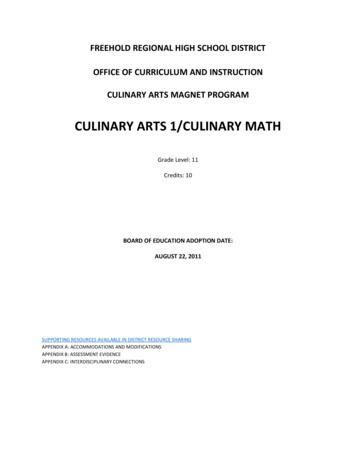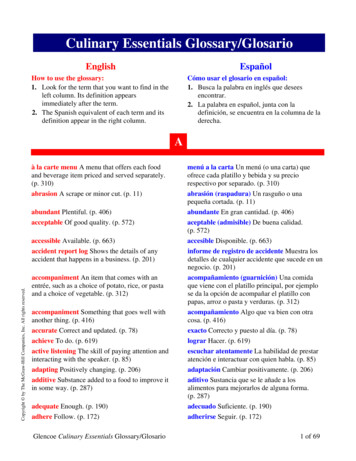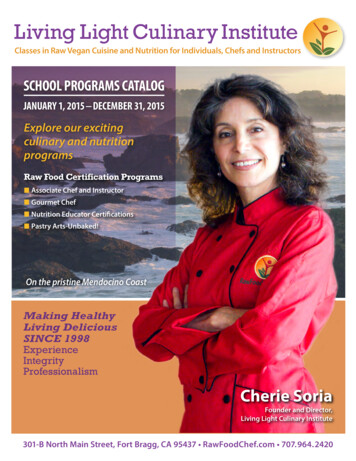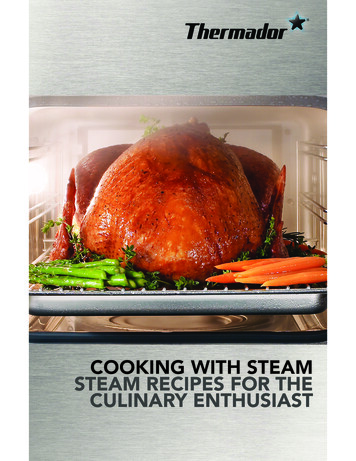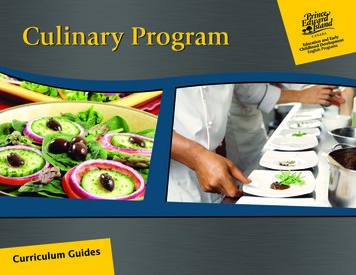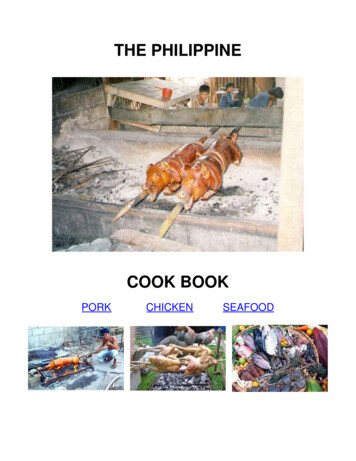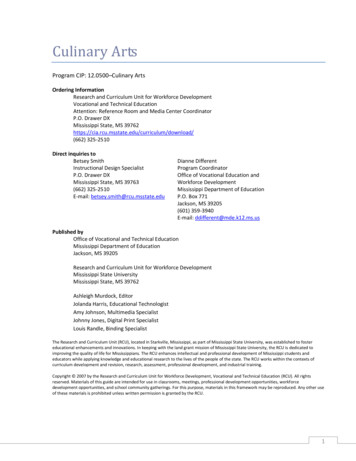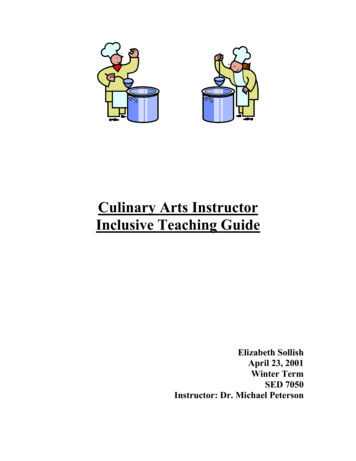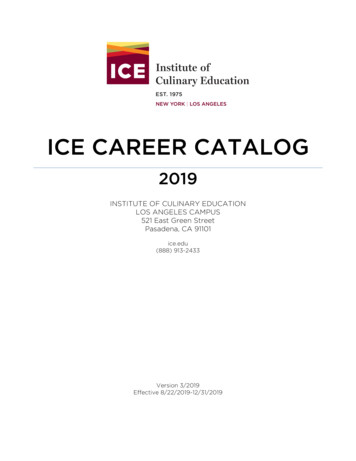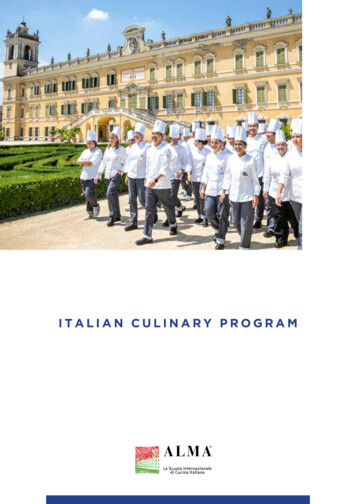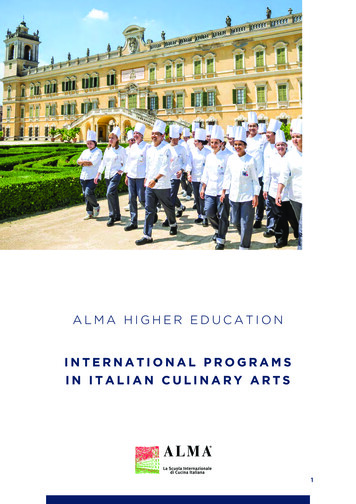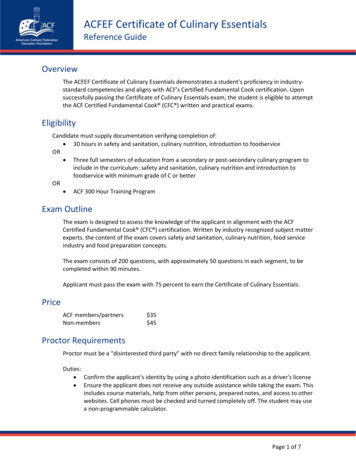
Transcription
ACFEF Certificate of Culinary EssentialsReference GuideOverviewThe ACFEF Certificate of Culinary Essentials demonstrates a student’s proficiency in industrystandard competencies and aligns with ACF’s Certified Fundamental Cook certification. Uponsuccessfully passing the Certificate of Culinary Essentials exam, the student is eligible to attemptthe ACF Certified Fundamental Cook (CFC ) written and practical exams.EligibilityCandidate must supply documentation verifying completion of: 30 hours in safety and sanitation, culinary nutrition, introduction to foodserviceOR Three full semesters of education from a secondary or post-secondary culinary program toinclude in the curriculum: safety and sanitation, culinary nutrition and introduction tofoodservice with minimum grade of C or betterOR ACF 300 Hour Training ProgramExam OutlineThe exam is designed to assess the knowledge of the applicant in alignment with the ACFCertified Fundamental Cook (CFC ) certification. Written by industry recognized subject matterexperts, the content of the exam covers safety and sanitation, culinary nutrition, food serviceindustry and food preparation concepts.The exam consists of 200 questions, with approximately 50 questions in each segment, to becompleted within 90 minutes.Applicant must pass the exam with 75 percent to earn the Certificate of Culinary Essentials.PriceACF members/partnersNon-members 35 45Proctor RequirementsProctor must be a “disinterested third party” with no direct family relationship to the applicant.Duties: Confirm the applicant's identity by using a photo identification such as a driver's license Ensure the applicant does not receive any outside assistance while taking the exam. Thisincludes course materials, help from other persons, prepared notes, and access to otherwebsites. Cell phones must be checked and turned completely off. The student may usea non-programmable calculator.Page 1 of 7
ACFEF Certificate of Culinary EssentialsReference Guide Remain in the presence of the applicant from the time the applicant starts the exam tothe time he or she finishes, or until the end of the maximum time allowed for the test,whichever comes first.Process:1. Applicant will verify eligibility by completing form and uploading documents ls2. Applicant will purchase exam in ACF Online Learning Center – www.acfchefs.org/LEARN3. ACF professional development team will release the exam and provide the designated proctorwith a PIN number.4. Proctor will input the PIN when the applicant is ready to test.5. Applicant has the opportunity to re-test within 30 days should he or she not pass the first time.6. Upon passing the exam, applicant will earn the ACFEF Certificate of Culinary Essentials, availableto print or download from the Learning Center, completed tab, in the ACF Online LearningCenter.InstructorsIf you are a culinary instructor interested in using the exam and certificate for your students,please contact the ACF professional development team at educate@acfchefs.net or (800) 6249458.Next stepsWithin one year of receipt of this certificate, the applicant can contact the ACF national officefor assistance with scheduling their practical and written exam for the ACF CertifiedFundamental Cook (CFC) or Certified Fundamental Pastry Cook (CFPC) certification.Recommended Reference Materials Culinary Review Quiz, ACF Online Learning Center, www.acfchefs.org/LEARNCulinary Nutrition, 30 hour, ACF Online Learning Center, www.acfchefs.org/LEARNSafety and Sanitation, 30 hour, ACF Online Learning Center, www.acfchefs.org/LEARNIntroduction to Foodservice, 30 hour, ACF Online Learning Center, www.acfchefs.org/LEARNACF 300 Hour Training Program, www.acfchefs.org/LEARNNutrition for Foodservice and Culinary Professionals, 9th edition, Drummond, B. and Brefere, L.,John, published by Wiley & Sons, Inc.ServSafe Coursebook, 7th edition, National Restaurant Association, published by Prentice Hall.On Food & Cooking, Revised Updated Edition, 2004, McGee, H., published by ScribnerPage 2 of 7
ACFEF Certificate of Culinary EssentialsReference GuideRequired CompetenciesSanitation and Safety Identify major contaminants related to foodborne illness.Describe microorganisms including requirements for growth and prevention methods.Demonstrate acceptable procedures when preparing potentially hazardous foods to includetime/temperature principles.Demonstrate good personal hygiene and health habits to include handwashing.Understand the requirements for proper receiving and storage of both raw and prepared foods.Identify the Hazard Analysis Critical Control Point (HAACP) during all food handling processes asa method for minimizing the risk of foodborne illness.Review Material Safety Data Sheets (MSDS) and explain their requirements in handlinghazardous materials.Demonstrate appropriate emergency policies for kitchen and dining room injuries.Discuss appropriate measures for insects, rodents and pest control eradication.Describe appropriate types and use of fire extinguishers used in the foodservice area.Review and apply the laws and rules of the regulatory agencies governing sanitation and safetyin a foodservice operation.Nutrition Identify and discuss dietary guidelines and recommended dietary allowances based on currentUSDA Food Guideline principles and food groups.Describe primary characteristics, functions and major food sources of major nutrients.List the primary characteristics, functions and sources of vitamins, water and minerals.Interpret food labels in terms of the portion size, ingredients and nutritional value.Identify common food allergies and determine appropriate substitutions. (i.e. gluten, sugar,lactose free)Evaluate and analyze recipes and menus using dietary guideline recommendations, food guidesand food labels.Discuss contemporary nutritional issues to include specialty diets, dietary trends, and religiousdietary laws (i.e. vegetarianism, heart-healthy menus, food allergies, alternative dieting,vegetarian, etc.)Discuss and demonstrate cooking techniques that apply sound nutritional principles and currentindustry trends.Introduction to Food Service Define the philosophy of the hospitality industry and its role in providing customer service.Trace the growth and development of the hospitality and tourism industry from its birth to itspresent day. Include names of restauranteurs, chefs, and hospitality entrepreneurs that helpedto shape the industry in the past and present day.Discuss and evaluate the importance of professional ethics as it applies to the foodserviceindustry.Outline the organization, structure and functional areas in various hospitality organizations asthey pertain to the functions of menu planning, purchasing, food production and service, foodand beverage controls, management, etc.Page 3 of 7
ACFEF Certificate of Culinary EssentialsReference Guide Identify and describe professional organizations associated with the hospitality and foodserviceprofession, and discuss these organizations role in preparing and advancing ones career in theindustry.Discuss industry trends as they relate to the various segments of the foodservice and hospitalityindustry.Basic Food Preparation Discuss proper kitchen safety including knife care.Discuss how to maximize food freshness, quality, safety and sanitation when serving hot foodsand cold foods.Discuss the principles of heat transfer as they relate to cooking methods including roasting andbaking, broiling, smiling, grilling, griddling, sautéing, frying, deep-frying, braising and stewing,poaching and steaming.Discuss recipe conversions.Explain the factors that affect taste, how we perceive those tastes and what we can do tooptimize a combination of seasonings and flavors when preparing and cooking food.Evaluating the differences in methods to develop flavor through preparation.Define the process for making classical stocks, soups, mother and compound sauces.Evaluate and analyze a variety of proteins, vegetables, legumes, grains and starches using moist,dry and combination cooking method.Sample Questions:1. When are strong impressions made in an interaction between a customer and a guest?a.b.c.d.First five secondsHalfway into the conversationIn a follow-up interactionAfter the conversion2. Who delivers the food from the kitchen to the guests according to the seat designation on theorder?a.b.c.d.ServersRunnersBussersDining room manager3. What term describes the local and state regulations on serving alcohol?Page 4 of 7
ACFEF Certificate of Culinary EssentialsReference Guidea.b.c.d.Liquor shop lawsMoonshine lawsDram shop lawsSpirit laws4. Intact whole grains, such as farro, are even better than foods made with whole grain flours, suchas whole wheat bread, because they have:a.b.c.d.Less fiberLower glycemic indexFewer mineralsNone of the above5. Which of the following is not considered a nutrient?a.b.c.d.WaterLipidsMineralsFruit6. What major allergen do miso, natto, shoyu and tempeh contain?a.b.c.d.SoyMilkWheatPeanuts7. Which food service areas must be sanitized?a.b.c.d.All those that come in direct contact with foodAll walls, floors and ceilingsAll paper and chemical storeroomsAll receiving areas8. What is the process called when you adjust the temperature reading of a thermometer based ona known nalysisThermal assurancePage 5 of 7
ACFEF Certificate of Culinary EssentialsReference Guide9. In pan-frying, or shallow frying, how much fat or oil should be used in the pan in comparison tothe size of the foods to be cooked?a.b.c.d.Just enough to coat the bottom of the panOne cup measure1 / 2 to 2/3 as deep as the product being cookedEnough to completely cover the product10. Cooking a food by radiant heat from above is known as what?a.b.c.d.BoilingBroilingBraisingRoasting11. What harmful by-product does the hydrogenation and excessive heating of fats produce?a.b.c.d.AntioxidantsFree radicalsTrans fatCholesterol12. How often should tools and equipment be cleaned?a.b.c.d.Every two hoursEvery four hoursEvery six hoursEvery eight hours13. For what reasons are stock pots tall with straight circular sides?a.b.c.d.For better heat transfer and quicker reductionFor the preservation of aromas and to increase the density of the stockTo make it easy to remove fat and strain bonesFor natural convection to help clarify the stock and slow the evaporation process14. Which soup is crystal clear with no traces of fat?a.b.c.d.ConsomméChowderBrothStock basedPage 6 of 7
ACFEF Certificate of Culinary EssentialsReference GuideAnswer Key1.2.3.4.5.6.7.ABCBDAA8.9.10.11.12.13.BCBCBDPage 7 of 7
Upon passing the exam, applicant will earn the ACFEF Certificate of Culinary Essentials, available to print or download from the Learning Center, completed tab, in the ACF Online Learning Center. Instructors If you are a culinary instructor intere
